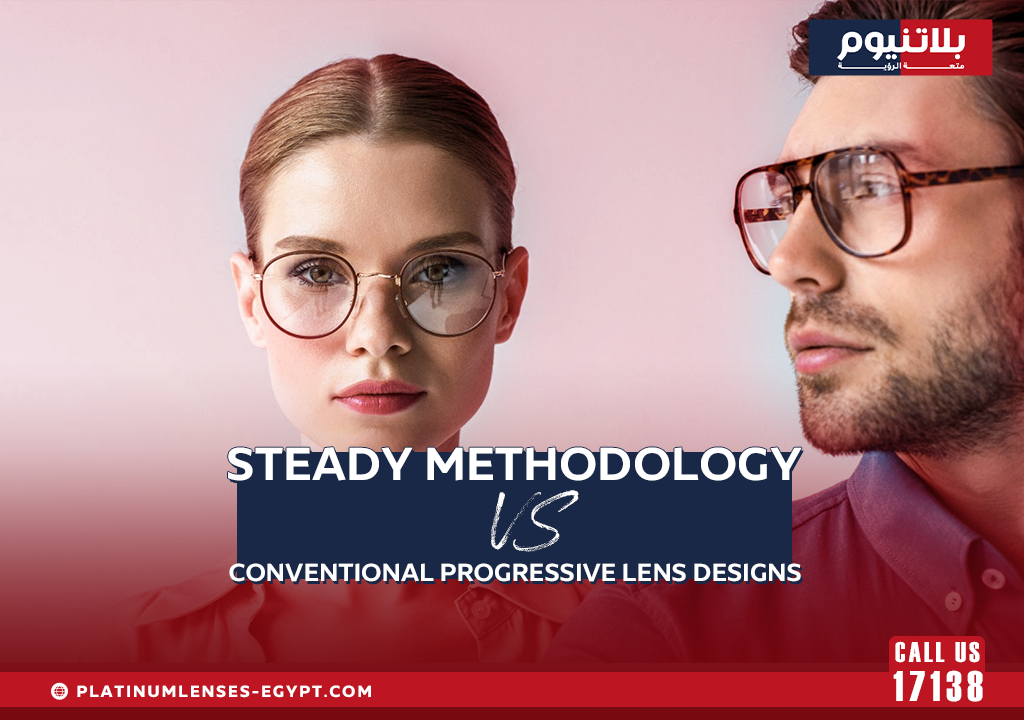Progressive lenses have revolutionized vision correction for presbyopia, offering a seamless transition between near, intermediate, and distance vision. However, not all progressive lenses are created equal. Conventional progressive lens designs often introduce unwanted distortions, making adaptation challenging for some wearers.
Steady Methodology, an advanced approach in lens design, aims to eliminate these issues by optimizing optical performance and stability. In this article, we will explore the key differences between Steady Methodology and conventional progressive lens designs, their impact on visual clarity, and why choosing the right technology matters for wearers.
Understanding Conventional Progressive Lens Designs
Conventional progressive lenses are designed based on pre-defined optical templates. While they provide a gradual shift between vision zones, they come with several limitations:
- Peripheral Distortions: The side areas of conventional progressives often introduce blur and visual discomfort, making activities like walking or driving difficult.
- Swim Effect: The distortion caused by rapid head movements creates a “swimming” sensation, making adaptation harder for new users.
- Limited Customization: These lenses follow a generic design, failing to accommodate individual eye movements and vision habits.
- Longer Adaptation Period: Wearers may experience discomfort before fully adjusting to their lenses, affecting their daily activities.
While conventional designs have been widely used, advancements in lens technology have paved the way for more refined solutions, such as Steady Methodology.
What is Steady Methodology?
Steady Methodology is an advanced approach to progressive lens design that prioritizes visual stability, minimal distortions, and enhanced wearer comfort. This technology leverages precise optical engineering to improve lens performance in the following ways:
- Minimizing Peripheral Aberrations: Unlike conventional designs, Steady Methodology reduces unwanted distortions in peripheral areas, providing clearer vision across the entire lens.
- Enhanced Visual Stability: It reduces the swim effect by optimizing the balance between different vision zones, ensuring a smooth and natural viewing experience.
- Individualized Customization: Steady Methodology incorporates wearer-specific data, adjusting lens geometry based on natural eye movements and posture.
- Seamless Adaptation: Users transitioning to Steady Methodology lenses often experience a shorter adaptation period compared to conventional designs.
Key Differences Between Steady Methodology and Conventional Designs
The table below highlights the fundamental differences between Steady Methodology and conventional progressive lens designs:
| Feature | Conventional Progressive Lenses | Steady Methodology |
|---|---|---|
| Peripheral Distortions | High levels of blur in side vision | Significantly reduced distortions |
| Swim Effect | Noticeable, especially during movement | Minimized for enhanced stability |
| Customization | Limited to standard prescriptions | Tailored to individual visual behavior |
| Adaptation Time | Longer, may take weeks to adjust | Faster adaptation with natural vision experience |
| Visual Comfort | Can cause discomfort in dynamic activities | Optimized for all-day wear and movement |
Benefits of Choosing Steady Methodology
Steady Methodology offers multiple advantages for presbyopic wearers looking for an improved progressive lens experience:
1. Superior Optical Performance
By eliminating excessive peripheral distortions, Steady Methodology ensures sharper vision across all viewing zones, reducing discomfort during daily activities.
2. Natural and Comfortable Vision
Since the swim effect is minimized, wearers can transition between different vision zones more smoothly, making Steady lenses ideal for reading, driving, and digital device use.
3. Personalized Vision Solutions
Unlike conventional progressives, Steady Methodology considers individual vision dynamics, such as eye movement patterns and posture, to create lenses that truly fit the wearer’s lifestyle.
4. Reduced Eye Strain
Wearers who switch to Steady lenses often report less eye fatigue, particularly those who spend long hours on screens or perform tasks requiring constant focus shifts.
5. Faster Adaptation
Since Steady lenses offer a more natural vision experience, new users can adjust quickly without the common discomfort associated with traditional progressive lenses.
Conclusion
Choosing the right progressive lens technology can significantly impact visual comfort and overall quality of life. While conventional progressive lenses remain a widely used option, they come with inherent drawbacks such as peripheral distortions, swim effect, and longer adaptation periods.
Steady Methodology represents a breakthrough in lens design, offering superior stability, sharper vision, and enhanced wearer satisfaction. For those seeking a smoother and more natural visual experience, upgrading to Steady lenses is a step toward better vision.
To ensure the best fit, it is recommended to consult an optician or eye care professional who can guide you in selecting the right progressive lens design tailored to your unique vision needs.

